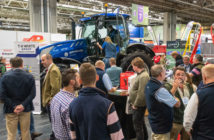New features of Drone Ag’s Skippy Scout crop monitoring software will be available to experience in virtual reality (VR) at LAMMA on stand 11.344 in hall 11. The 2020 LAMMA gold ‘future innovation’ award winners will offer visitors a chance to experience the new features using a VR headset. “The headset will show users how Skippy Scout enables them to see a whole field from above and zoom in on specific parts of the field that have been imaged by a drone,” explains founder, Jack Wrangham.
The so-called ‘Scout Spheres’ interface provides users with interactive whole field viewing for the first time. “We are the only provider to offer users a drone-enabled, full field overview that includes the ability to focus on any area of the field and choose where to inspect at leaf-level,” he says.
Used by hundreds
Mr Wrangham stresses that this is not future technology and that drones with this software are already being used on farms throughout the UK. “A drone with Skippy can walk a crop 20 times faster than a farmer on foot. PDF reports are generated immediately showing the green area index and the number of plants. This technology is being used by hundreds of farmers already and the data will soon be used to support the use of spraying drones too,” he says.
Spraying drones
To show the full extent to which drone captured images can improve crop management, Drone Ag will also be exhibiting one of the latest DJI spraying drones that has a 20-litre capacity and is also capable of granular spreading. “With data from Skippy, users can program spraying drones like the DJI model we will have on the stand. Using this technology can help to reduce soil compaction and the use of chemical by deploying a spraying drone to target only the plants that require treatment,” he explains.
Skippy Scout can count cereals, OSR, soybeans, beans, peas, and potatoes, offering an accurate total of plants in an image, as well as the number of plants per square metre. “The new software is only £30 per month and is compatible with Apple devices and most off-the-shelf drones. It can save time, find weeds and disease faster, and harvest the data needed to improve the sustainability of broad acre crop farming,” he concludes.




